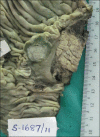Periampullary adenocarcinoid: diagnostic dilemma
- PMID: 24701112
- PMCID: PMC3968628
- DOI: 10.4103/0974-2727.119875
Periampullary adenocarcinoid: diagnostic dilemma
Abstract
The growth in periampullary region needs proper evaluation as they can arise from duodenum, pancreas and extra hepatic biliary tree. We have reported a case of adenocarcinoid of duodenum presenting as periampullary growth with obstructive jaundice. Histologically, tumor displayed biphasic pattern, i.e. tubuloglandular architecture with admixed sheets of neuroendocrine cells without pancreas and extra hepatic biliary tree involvement. The adenocarcinoids are of great diagnostic challenges for the pathologist interpreting endoscopic biopsy for the frequent misinterpretation as negative due to their submucosal location or as adenocarcinomas due to tubulo-glandular architecture.
Keywords: Adenocarcinoids; carcinoids; periampullary region.
Conflict of interest statement
Figures
References
-
- Costantini M, Montalti R, Rossi G, Luisa L, Masetti M, Di Benedetto F, et al. Adenocarcinoids tumor of extra hepatic biliary tree. Int J Surg Pathol. 2008;16:455–57. - PubMed
-
- Levy AD, Taylor LD, Abboth RM, Sobin LH. Duodenal carcinoids: Imaging features with clinical - pathological comparison. Radiology. 2005;237:967–72. - PubMed
-
- Levendoglu H, Cox CA, Nadimpalli V. Composite (adenocarcinoid) tumor of gastrointestinal tract. Dig Dis Sci. 1990;35:519–25. - PubMed
-
- Hatzitheoklitos E, Buchler MW, Friess H, Poch B, Ebert M, Mohr W, et al. Carcinoids of ampulla of vater. Clinical characteristics and morphological features. Cancer. 1994;73:1580–8. - PubMed
-
- Ferrando Marco J, Pallas Regueira A, Moro Valdezate D, Fernandez Martinez C. Collision tumor of the ampulla of Vater: Carcinoid and adenocarcinoma. Rev Esp Enferm Dig. 2007;99:235–8. - PubMed
Publication types
LinkOut - more resources
Full Text Sources
Other Literature Sources




